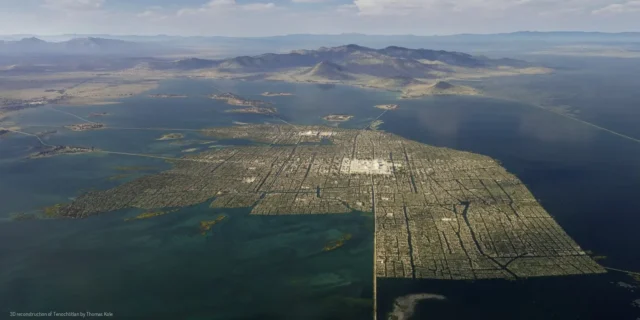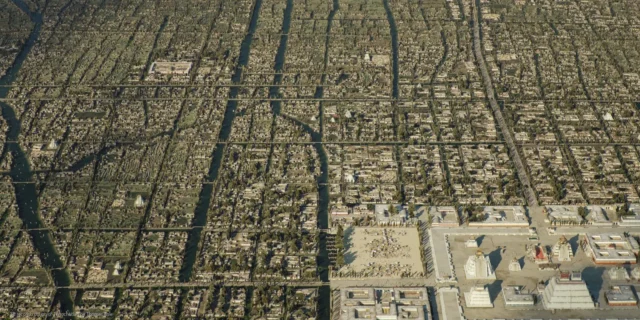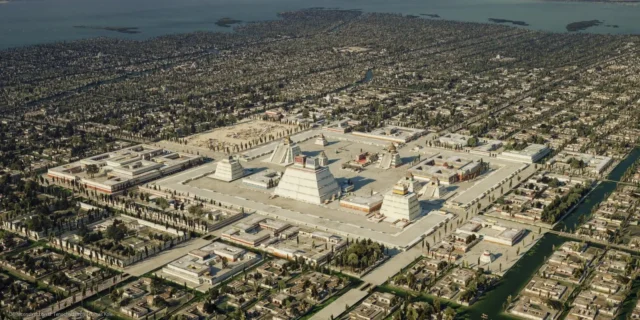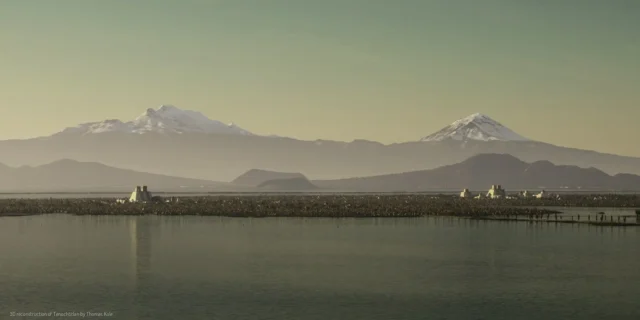Recently Thomas Kole a digital artist made the 3D reconstruction of Tenochtitlan and so far all the media have been filled with these beautiful images.
In the words of Thomas Kole for wired magazine he says:
My interest grew as I explored the maps of Mexico City. First of all, I am originally from Europe, where we hardly learn about Native Americans and pre-Columbian civilizations. We are taught that they were very primitive people. But, as I learned more about the Mexica capital, it seemed that it was not only a very large and organized city, but also one of the largest in the world.”
Thomas Kole for wired magazine
That is why here we bring you a great compilation of all the images and videos of the 3D reconstruction of Tenochtitlan.
To begin with we leave you with this video made by another animation studio that also made a 3D reconstruction of Tenochtitlan.
In the year 1518, Mexico-Tenochtitlan, once standing modestly on the waters of Lake Texcoco, has blossomed into a vibrant metropolis, the jewel of an empire that governs and collects tribute from more than 5 million subjects. This imposing city is home to a population of 200,000 citizens dedicated to agriculture, art, commerce, war, religion and administration. In its time, Tenochtitlan held the title of one of the most colossal cities in the world.
Today, this majestic city is known as Mexico City.
Yet little remains of ancient Tenochtitlan. What did this city, built painstakingly over the waters, look like? Based on painstaking historical research and archaeological findings, backed by the shared knowledge of numerous scholars, I have sought to resurrect Tenochtitlan as authentically as possible.

A very different world
Five hundred years ago, our world was remarkably different. As you immerse yourself in this evocative narrative, I invite you to imagine the nuances of the scent of salt in the air and the intriguing hint of smoked chile. Enter the melodious music of the Nahuatl language and the soft murmur of canoes gliding through the intricate canals. Open your senses to the songs of the birds that fill the lush trees and allow the warm embrace of the sun to caress your skin.
In this fascinating environment, people dress in delicate cotton garments and display their skills in various trades. They work tirelessly in the fields, bring delicious delicacies to life, engage in lively trade, and practice their arts under the protective shade of leafy trees and cozy awnings.

An Organized City
Tenochtitlan’s urban design, characterized by its grid pattern, highlights the hierarchical structure of this ancient city. Each neighborhood is meticulously planned and has its own markets, schools and workshops, creating a vibrant and autonomous community network.
Constant attention to the irrigation ditches ensures an efficient means of transportation for both its inhabitants and their goods, while steps and bridges weave the intricate urban fabric of this impressive metropolis.

Unique Architecture
Against the backdrop of modest one-story dwellings, imposing structures dominate the landscape: from the majestic double temple in the heart of the city to the local sanctuaries that honor their divinities in the different neighborhoods. The Sacred Precinct, which houses the venerated Templo Mayor, represents the absolute epicenter of the city. Right next to it is the sumptuous palace of the respected tlahtoani Motecuhzoma Xocoyotzin, accompanied by other temples, educational centers, exuberant gardens and a captivating vivarium.

Tlatelolco
To the north of the great Tenochtitlan lies Tlatelolco, its sister city. Over time, these two cities amalgamated, although Tlatelolco remained subordinate to Tenochca rule.
In this metropolis, a market of vital importance is erected, which becomes a meeting point for the exchange of products coming from the farthest corners of the vast empire.
These renderings are a great view of the 3D reconstruction of Tenochtitlan.

The Mexico Basin
The Basin of Mexico is surrounded by majestic volcanoes, Popocatepetl and Iztaccihuatl being the most prominent among them.
Along its slopes, waters from rainfall and springs converge to form a body of saline water in the heart of this region.
The altitude of the Basin exceeds 2000 meters above sea level, even at its lowest points, giving it a unique and spectacular topography.

The lake surrounding the city
Building a city in the middle of a lake poses a constant challenge against the aquatic elements.
An elaborate system of irrigation ditches, canals, sluices and a 16-kilometer-long albarradón became the ingenious solution that supplied fresh water to the Mexica people from the surrounding high mountains.
This ingenious compartmentalization system ensures that the city is surrounded by saline water, while salt water is retained at the eastern end of the lake. In addition, a strategically arranged aqueduct, extending from Chapultepec, supplies the city with a constant supply of potable water.

Las Chinampas
The Mexica develop cultivation plots by driving stakes into the lake bed and carefully filling the space with soil and gravel.
In these fertile chinampas, a wide range of foods are harvested, including corn, beans, squash, chili peppers and flowers.
This innovative agricultural system not only sustains the population, but also enables growth in terms of both territorial extension and number of inhabitants of the city.

Tlacopan and Tetzcoco
The Mexico Basin has been home to human communities for millennia. Along the shores of the lake, diverse towns and cities emerged to share this unique environment. Among the most prominent, Tenochtitlan, Tlacopan and Tetzcoco joined together to form the powerful Triple Alliance, which marked a fundamental chapter in the history of the region.
The city of Tenochtitlan is connected to the mainland through an intricate network of causeways that extend to Tlacopan, Azcapotzalco, Tepeyacac and other more distant places. These causeways not only facilitate transportation and trade, but also strengthen the ties between the diverse communities that make up the great basin of Mexico.
Conclusion on the 3D Reconstruction of Tenochtitlan
Undoubtedly this is a great work that helps us to understand more about the original Tenochtitlan mind if you want to see the comparative images of this project you can enter their official site by clicking here.
Where with the images of the 3D reconstruction of Tenochtitlan comparing yesterday and today you can get an idea of the locations.




















